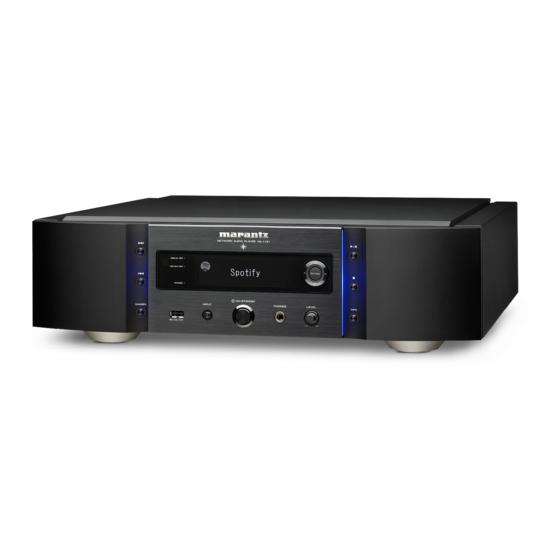
Marantz NA-11S1 Overview
Musical mastering
Hide thumbs
Also See for NA-11S1:
- Owner's manual (65 pages) ,
- Manual del usuario (65 pages) ,
- Getting started manual (11 pages)
Advertisement
White paper
Marantz Musical Mastering
NA-11S1, v1.0, Feb 2013
Introduction
Since the start of the era of digital recording of music, technology
has been faced with the challenge of maximising the accuracy
of reproduction. The initial problem was the small number of bits
available for the conversion of analogue signals into digital. In the
early '80s the first attempts were made to create more audible
resolution than the bits actually produced. In this way, the first
CD player from Philips and Marantz worked with the 14-Bit-D/A-
Converter using a process called noise-shaping and achieved real
precision of 16 bits and four-fold oversampling, and thus played a
leading role.
With the growing number of high resolution audio files in recent
years, the issue has in fact been reversed, because current master
and media can easily deal with 24 or even 32-bit and provide the
necessary digital filtering for playing up to 48 bits per sample. Now
the issue centers on reducing the surplus resulting resolution and
the ensuing huge bandwidths by hundreds of kilohertz as efficiently
as possible to usable frequencies and the common resolutions of
16 (CD) to 24 bits. If the excess bits were shortened to simply re-
move the excess bits, audible errors would be created and any higher
resolution gained would be irretrievably lost.
In the NA-11S1 Marantz has implemented new algorithms for digital
signal processing developed in-house for the first time and the result
is a surprisingly low loss of resolution. For this purpose, Marantz
has utilised new signal processing technology previously exclusively
reserved for high-end, professionally equipped mastering studios.
www.marantz.eu
Solution
To maximise audible resolution, three methods are combined:
Oversampling, Noise Shaping and Dithering.
Through oversampling intermediate samples between 2 original
samples are calculated, thus achieving a multiplication of the
sampling rate. To calculate the intermediate samples with
sufficient accuracy the resolution of the audio data needs to be
increased significantly. In our application we found additional
24 bits adequate giving us a total resolution of 48 bits.
The noise shaping offsets digital noise components through clever
filtering from the audible frequency range into the frequency range
beyond 20 kHz, which is no longer perceptible.
With dithering, the desired signal is modulated with noise to reduce
inaccuracies caused through the forcible conversion of resolutions.
The type and distribution of the noise determine the quality of
the sonic result. Marantz established the optimal variant through
extensive listening tests and trial series.
As a result of the correct combination of the three methods and the
correct choice of the respective algorithm and its application, more
details than the simple conversion of the original signal could be
perceived, thus significantly higher-resolution sound reproduction
could be achieved.
Marantz Musical Mastering | NA-11S1 | V1.0, Status Feb. 2013 | 1
Advertisement
Table of Contents

Summary of Contents for Marantz NA-11S1
- Page 1 For this purpose, Marantz could be achieved. has utilised new signal processing technology previously exclusively reserved for high-end, professionally equipped mastering studios. www.marantz.eu Marantz Musical Mastering | NA-11S1 | V1.0, Status Feb. 2013 | 1...
- Page 2 “smallest” bit) and returns it to the input of the quantizer tributed in a statistically favourable man- ner, the sound is closer to the original. www.marantz.eu Marantz Musical Mastering | NA-11S1 | V1.0, Status Feb. 2013 | 2...
- Page 3 The frequency behaviour (e.g. spectrum) of our noise generator looks like this. It can be seen that all frequencies have about the same amplitude – thus our noise generator really generates ‘white noise’. www.marantz.eu Marantz Musical Mastering | NA-11S1 | V1.0, Status Feb. 2013 | 3...
- Page 4 The distinct improvement in sound is manifested in detail in individual instruments, space and richer tones. www.marantz.eu Marantz Musical Mastering | NA-11S1 | V1.0, Status Feb. 2013 | 4...
















Need help?
Do you have a question about the NA-11S1 and is the answer not in the manual?
Questions and answers